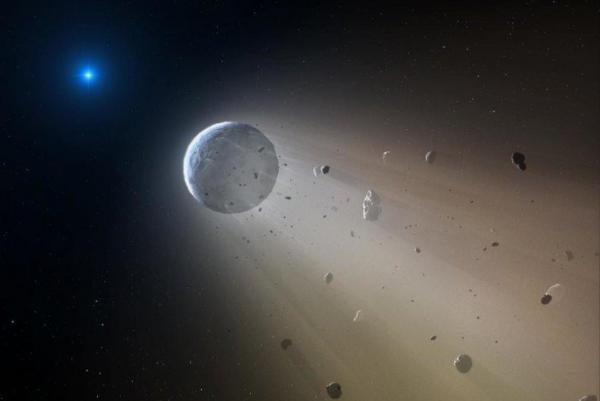CAMBRIDGE, Mass., Oct. 21 (UPI) — Astronomers have spotted a rocky planet being destroyed by its host star, a cosmic “Death Star.” The planet is locked in a death spiral around the distant white dwarf, slowly disintegrating as its orbit dips closer and closer.
Researchers at the Harvard-Smithsonian Center for Astrophysics (CfA) noticed the anomaly while analyzing data collected by NASA’s Kepler K2 mission, which looks for planets by watching for dimming stars.
Researchers first recognized a dip in the white dwarf’s brightness every 4.5 hours, suggesting an orbit of approximately 520,000 miles. Closer observation showed fragments of the planet also result in less pronounced dimming every four to five hours. Together, the orbital fragments total a mass similar to Ceres, the solar system’s largest asteroid and dwarf planet.
It’s the first time scientists have observed a planetary object orbiting a white dwarf.
“This is something no human has seen before,” lead researcher Andrew Vanderburgsaid in a press release. “We’re watching a solar system get destroyed.”
The dimming signature suggests a comet like shape trailing from the largest planetary fragment. A permanent dust cloud likely surrounds the disintegrating planet.
This particular white dwarf lies 570 light-years from Earth in the constellation Virgo. Most white dwarfs consist of a carbon and oxygen core with a thin hydrogen or helium shell. They’re what’s left over after a dying star expands to become a red giant then slowly sheds its outer layers.
But this white dwarf is slightly different. Its light spectrum reveals traces of silicon and iron. Researchers refer to such white dwarfs as “polluted.” It’s been theorized the heavier elements are the result of the star consuming a planet or asteroid. Some polluted white dwarfs are even surrounded by a thin disc of debris.
This white dwarf has pollution, debris and a rock planet caught in a death spiral — confirming scientists’ theories.
“We now have a ‘smoking gun’ linking white dwarf pollution to the destruction of rocky planets,” said Vanderburg.
While it’s not clear how a planet becomes locked in a death spiral, its fate is clear. Eventually the rocky objects will be no more. As they are sucked closer and closer, they’re increasingly vaporized by the white dwarf’s intense heat.
Vanderburg and his colleagues detailed their discovery in a new paper published in the journal Nature.





